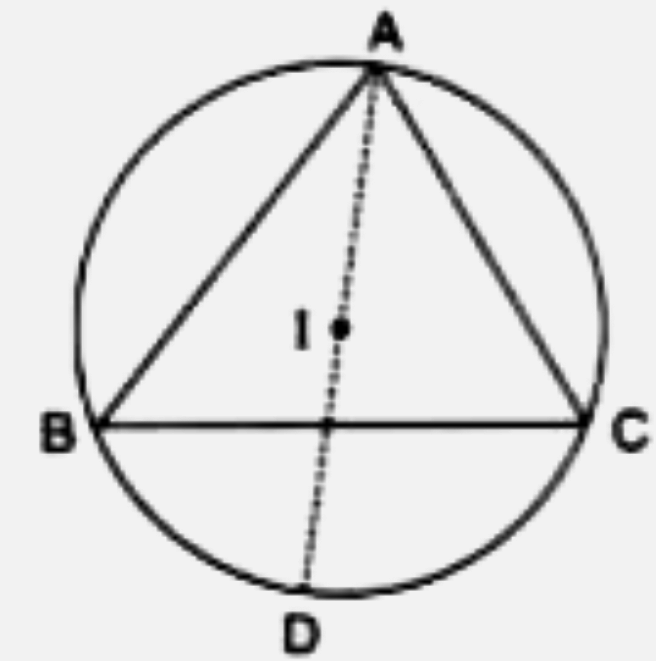If I is the incentre of a !ABC , then IA:IB:IC is equal to
cosecA2:cosecB2:cosecC2
sinA2:sinB2:sinC2
secA2:secB2:secC2
none of these
The correct Answer is:A
To find the ratio IA:IB:IC where I is the incenter of triangle ABC, we can follow these steps:
Step 1: Understand the Incenter
The incenter I of a triangle is the point where the angle bisectors of the triangle intersect. It is also the center of the incircle, which is tangent to each side of the triangle.
Step 2: Use the Relationship of Distances
The distances from the incenter I to the vertices A, B, and C can be expressed in terms of the radius R of the incircle and the angles of the triangle:
- IA=RsinA2
- IB=RsinB2
- IC=RsinC2
Step 3: Set Up the Ratio
Now, we can set up the ratio of these distances:
IA:IB:IC=RsinA2:RsinB2:RsinC2
Step 4: Simplify the Ratio
Since R is a common factor in all three terms, we can simplify the ratio by canceling R:
IA:IB:IC=1sinA2:1sinB2:1sinC2
This can be rewritten as:
IA:IB:IC=sinB2:sinA2:sinC2
Step 5: Use the Sine-Cosine Relationship
Using the identity sinθ=cos(90∘−θ), we can relate the sine terms to cosine terms:
IA:IB:IC=cosA2:cosB2:cosC2
Final Result
Thus, the final ratio is:
IA:IB:IC=cosA2:cosB2:cosC2
The incenter I of a triangle is the point where the angle bisectors of the triangle intersect. It is also the center of the incircle, which is tangent to each side of the triangle.
The distances from the incenter I to the vertices A, B, and C can be expressed in terms of the radius R of the incircle and the angles of the triangle:
- IA=RsinA2
- IB=RsinB2
- IC=RsinC2
Now, we can set up the ratio of these distances:
IA:IB:IC=RsinA2:RsinB2:RsinC2
Since R is a common factor in all three terms, we can simplify the ratio by canceling R:
IA:IB:IC=1sinA2:1sinB2:1sinC2
This can be rewritten as:
IA:IB:IC=sinB2:sinA2:sinC2
Using the identity sinθ=cos(90∘−θ), we can relate the sine terms to cosine terms:
IA:IB:IC=cosA2:cosB2:cosC2
Thus, the final ratio is:
IA:IB:IC=cosA2:cosB2:cosC2
Topper's Solved these Questions
- BOOK - OBJECTIVE RD SHARMA ENGLISHCHAPTER - PROPERTIES OF TRIANGLES AND CIRCLES CONNECTED WITH THEMEXERCISE - Chapter Test55videos
PROPERTIES OF TRIANGLES AND CIRCLES CONNECTED WITH THEM
- BOOK - OBJECTIVE RD SHARMA ENGLISHCHAPTER - PROPERTIES OF TRIANGLES AND CIRCLES CONNECTED WITH THEMEXERCISE - Section II - Assertion Reason Type13videos
PROPERTIES OF TRIANGLES AND CIRCLES CONNECTED WITH THEM
- BOOK - OBJECTIVE RD SHARMA ENGLISHCHAPTER - PLANE AND STRAIGHT LINE IN SPACE EXERCISE - Chapter Test31videos
PLANE AND STRAIGHT LINE IN SPACE
- BOOK - OBJECTIVE RD SHARMA ENGLISHCHAPTER - REAL FUNCTIONS EXERCISE - Chapter Test58videos
REAL FUNCTIONS
Similar Questions
Assertion: If I is the incentre of △ABC,then|vec(BC)| vec(IA) +|vec(CA)| vec(IB) +|vec(AB)| vec(IC) =0Reason:IfOistheorig∈,thentheposition→−−→rofcentrof/_\ABCis−−→OA+−−→OB+−−→OC3
View SolutionIn a triangle ABC , the line joining the circumcentre and incentre is parallel to BC, then Cos B + Cos C is equal to:
View SolutionIf I is the incentre of a ΔABC such that ∠A=60∘, then AI =
View SolutionIn any ΔABC line joiningcircumcentre (O) and incentre (I) is parallel to AC, then OI is equal to
View SolutionIn ΔABC, I is the incentre, Area of ΔIBC,ΔIACandΔIAB are, respectively, Δ1,Δ2andΔ3. If the values of Δ1,Δ2andΔ3 are in A.P., then the altitudes of the ΔABC are in
View SolutionIn the given I is the incentre of triangle ABC. AI produced meets the circumcircle of triangle ABC at point D. Given that angle ABC=48∘and angle ABC=72∘, calculate:

∠BICView SolutionIn the given I is the incentre of triangle ABC. AI produced meets the circumcircle of triangle ABC at point D. Given that angle ABC=48∘and angle ABC=72∘, calculate:

∠DCIView SolutionIn the given I is the incentre of triangle ABC. AI produced meets the circumcircle of triangle ABC at point D. Given that angle ABC=48∘and angle ACB=72∘, calculate:

∠BCDView SolutionIn the given I is the incentre of triangle ABC. AI produced meets the circumcircle of triangle ABC at point D. Given that angle ABC=48∘and angle ACB=72∘, calculate:

∠CBDView SolutionIf I is the centre of a circle inscribed in a triangle ABC, then ∣∣∣−−→BC∣∣∣−→IA+∣∣∣−−→CA∣∣∣−→IB+∣∣∣−−→AB∣∣∣−→IC is
View Solution

